15 Benefits of Picture Books for Older Readers with Practical Examples
Explore the surprising benefits of picture books for older readers! This article reveals how these visual gems provide valuable insights and enriching experiences beyond traditional children’s literature.
Join me, an experienced Montessori elementary teacher, as we explore just how great picture books are for older readers. We’ll discover how they improve critical thinking skills and ignite a love for learning.
Whether you’re a teacher looking to expand your students’ reading horizons or a parent aiming to inspire your child, keep reading to find out why picture books are a valuable addition to your reading repertoire.
💡📚💡📚💡
Our Top 3 Picture Book Picks for Older Readers
Whose Poop Is That?
Carl the Cantankerous Cat
The Girl Who Loved Wild Horses
➡️ Loving these? Scroll on for even more great picks!
Benefits of Picture Books for Older Readers with Examples
Picture books are not just for young children. Older readers can also reap the benefits of these visually engaging stories.
With their captivating illustrations and thought-provoking narratives, picture books have something to offer readers of all ages. From stimulating critical thinking to nurturing a lifelong love for reading, picture books offer numerous benefits.
Let’s explore the many advantages these literary treasures have to offer!
1. Picture books have detailed illustrations that attract readers.
Picture books offer an immersive experience where vibrant illustrations and captivating characters bring stories to life. As older readers flip through the pages, they visually explore each scene. This allows them to engage with the story on a deeper level.
This visual immersion makes reading more enjoyable and helps readers connect with the characters and themes.
Picture Book Example
The Art of Miss Chew by Patricia Polacco is a book that really holds the attention of older children.
As readers turn the pages of this picture book, they enter the world of Trisha, the protagonist, and her artistic journey.
The detailed illustrations and relatable characters bring the story to life, immersing readers in Trisha’s exploration of art.
Here’s a preview of one of the stunning spreads in this visually captivating book:
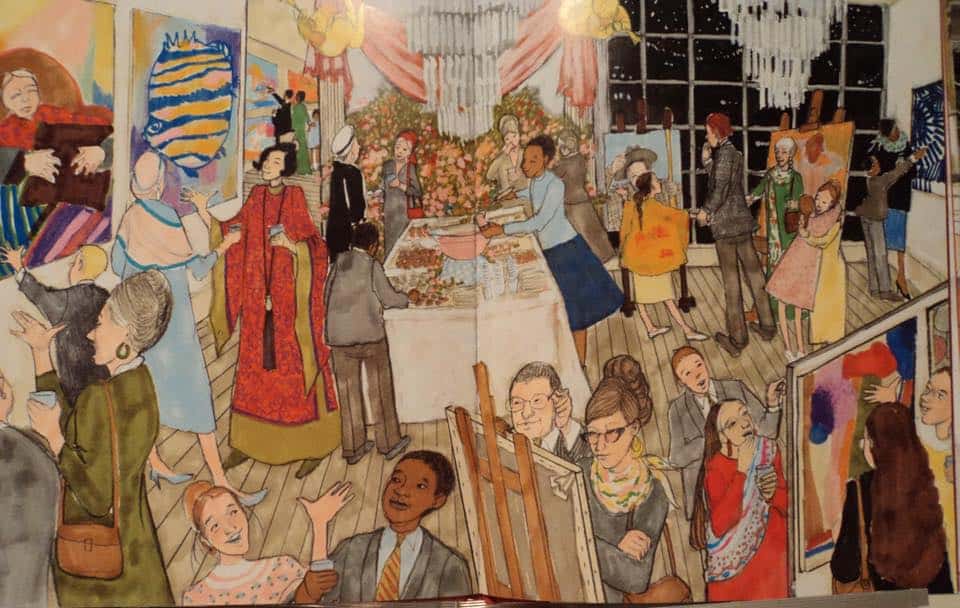
2. Picture books enhance critical thinking skills.
Picture books boost critical thinking by encouraging readers to connect text and images, make inferences, and predict what happens next.
This process encourages active engagement and stimulates the brain’s problem-solving faculties. This prepares children to navigate complex narratives and real-world scenarios with confidence and creativity.
Picture Book Example
A prime example of this is Whose Poop Is That? by Darrin Lunde.
This book encourages critical thinking in children by presenting them with a mystery to solve: identifying the animal based on its poop.
Readers study the illustrated scat and use clues to figure out which animal it belongs to.
This intriguing and hilarious book requires children to analyze visual clues, make inferences, and draw conclusions. As a result, they are honing their critical thinking skills in a fun and engaging way.
Curious about this book? Here’s a great read aloud by Angelia Dyer:
3. Picture books encourage older, reluctant readers.
Picture books serve as a powerful tool in enticing reluctant readers to engage with literature. With captivating visuals complementing the narrative, even the most hesitant reader can find themselves drawn into the story.
Additionally, the shorter length of picture books makes reading feel easier and less intimidating, especially for reluctant readers.
Picture Book Example
After the Fall (How Humpty Dumpty Got Back Up Again) by Dan Santat is a great example of this.
This is an inspiring tale of resilience that captivates reluctant readers with its engaging storyline and stunning illustrations. The relatable theme of overcoming obstacles and the hopeful message of perseverance resonate deeply with readers, motivating them to keep turning the pages.
4. Picture books expand vocabulary in older readers.
Picture books play a crucial role in expanding vocabulary for older students, seamlessly blending learning with enjoyment. Through engaging stories and captivating illustrations, picture books are able to introduce advanced vocabulary in a way that sparks curiosity.
As readers encounter new words that prompt them to pause and ponder, they set off on a journey of exploration. This sometimes leads to them reaching for the dictionary to explore the richness of language further. Bonus!
Picture Book Example
Carl the Cantankerous Cat by Donna Paul and Karen Patel brings entertainment and education together PURRRfectly!
Readers are irresistibly pulled into Carl’s mischievous adventures, staying engaged and entertained with every turn of the page.
And while it’s an entertaining read, it’s also a tool for expanding readers’ vocabulary.
In addition to its engaging storyline, this book intentionally integrates advanced vocabulary words, aiming to stretch readers’ knowledge and challenge them to explore new linguistic horizons. On ever page, readers are presented with opportunities for learning and discovery, enhancing their language skills in an engaging and enriching manner.
Plus, you’ll find word definitions conveniently tucked away in the glossary at the end of the book, ensuring accessibility and facilitating comprehension.
5. Picture books promote a love of reading in older readers.
Picture books play a vital role in nurturing a lifelong love of reading. By exposing readers to a diverse array of stories and themes, picture books offer something for every taste and interest.
This exposure often sparks a passion for reading as readers discover stories that resonate with them, igniting a desire to explore more books and delve deeper into the world of literature.
Picture Book Example
The Man Who Walked Between the Towers by Mordicai Gerstein
As readers follow the daring feat of Philippe Petit walking between the Twin Towers of the World Trade Center, they are drawn into an extraordinary tale of courage and determination.
The book’s engaging narrative and breathtaking visuals capture the interest of older readers, inspiring a sense of awe and wonder.
By experiencing the magic of storytelling at its finest, children are encouraged to explore more books and discover the joy of reading for themselves.
Listen to young reader Angelica read this book aloud on her channel:
6. Picture books increase emotional intelligence in readers.
Interestingly, picture books are powerful tools for nurturing emotional intelligence, tackling profound topics like bullying, divorce, and grief. Through compelling narratives and vivid illustrations, these stories spark meaningful discussions and encourage readers to reflect deeply on their themes.
By exploring diverse perspectives and empathizing with characters’ experiences, children develop a heightened sensitivity to emotions and a greater understanding of the world around them.
Picture Book Example
Those Shoes by Maribeth Boelts is an exemplary picture book that showcases diverse perspectives and emotions.
Kids can relate to Jeremy’s quest for special footwear, learning about his wants and challenges, and gaining insights into human emotions.
Through his experiences, readers learn about empathy, kindness, and the importance of gratitude, fostering emotional intelligence and compassion.
Check out this spread from this powerful picture book:
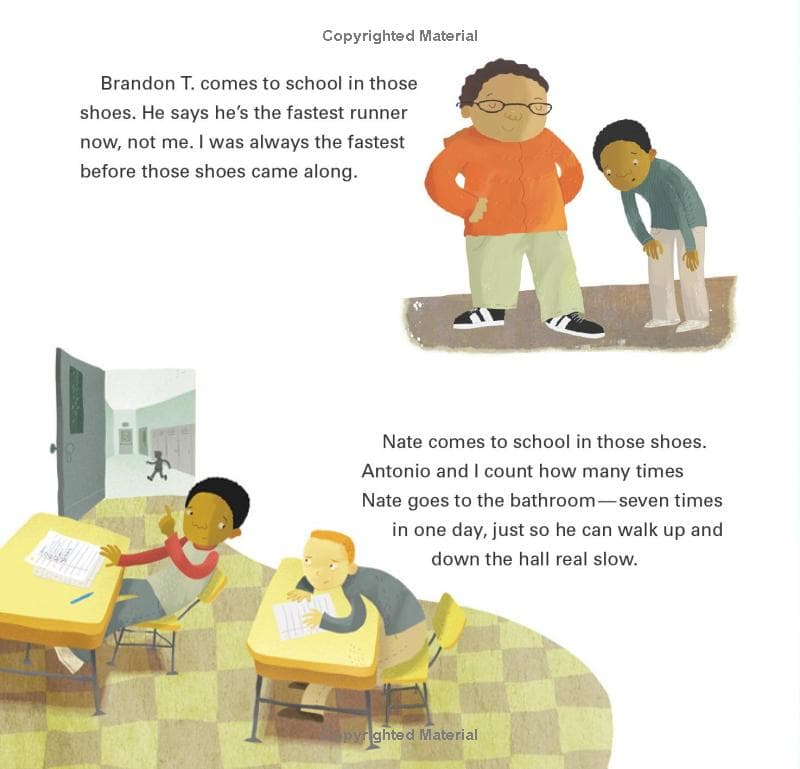
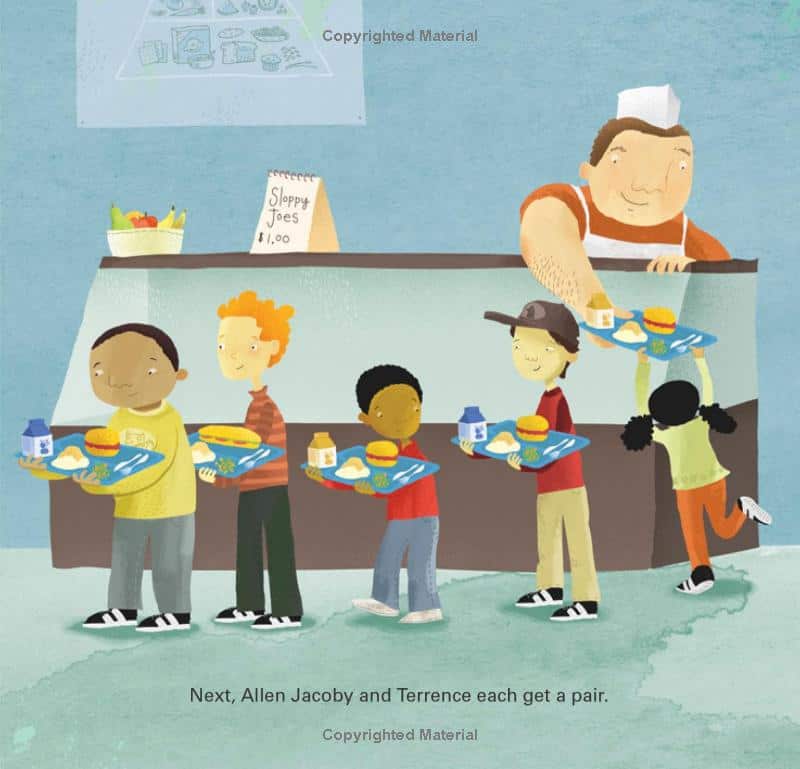
7. Picture books open up new worlds for older readers.
Picture books serve as windows into diverse worlds, letting readers explore various cultures, traditions, and landscapes. It is through colorful illustrations and captivating stories that children are transported to new places and introduced to characters and customs they might not encounter otherwise.
As a result, children develop empathy and understanding for others who may lead different lives from their own. Through exposure to various cultures and traditions, children become more open-minded and curious about the world around them, sparking their interest in exploration and learning.
Picture Book Example
Follow the main character CJ as he experiences the world around him while riding the bus in Last Stop On Market Street by Pena Matt de la.
This heartwarming story takes kids on a journey through bustling city streets, showing them the beauty and excitement of urban life. It’s a great way for young readers to explore and appreciate the diversity of city environments.
Older readers will appreciate the vibrant illustrations and captivating storytelling that brings to life a diverse array of cultures and experiences. They will be transported to new worlds, fostering empathy and broadening their understanding of the world around them.
Listen to Magical Little Minds’ read aloud of this great book:
8. Picture books are actually made at higher reading levels.
Picture books are crafted with vocabulary and themes that challenge readers, despite their seemingly simple format. While chapter books may lack the visual elements of picture books, they often feature straightforward language and predictable storylines.
On the other hand, picture books offer older readers a rich reading experience by using sophisticated vocabulary and intricate storytelling, engaging them in a deeper and more intellectually stimulating narrative journey.
Picture Book Example
The Girl Who Loved Wild Horses by Paul Goble stands out as a picture book written at a higher reading level due to its sophisticated language and complex narrative structure.
Unlike traditional children’s books, it presents intricate themes and nuanced storytelling, challenging readers to engage with deeper concepts.
This elevated writing style provides older readers with a more immersive and intellectually stimulating reading experience, making it an excellent choice for expanding their literary horizons.
Experience this book through this great Story Time read aloud:
9. Picture books build background knowledge.
Picture books explore various topics through detailed illustrations and concise text, encompassing history, science, social issues, and cultural traditions. By introducing readers to diverse subject matter, they expand their understanding of the world and encourage further exploration and learning.
This expanded awareness not only enhances comprehension and critical thinking skills but also cultivates empathy and a deeper appreciation for the interconnectedness of the world around them.
Picture Book Example
Pass Go and Collect $200: The Real Story of How Monopoly Was Invented by Tanya Lee Stone tells the story of how Monopoly was made. It helps kids learn about the time when the game was invented and the people behind it.
Readers will understand more about history and how things were back then. It also helps you think about why Monopoly is important then and now.
The visuals in this book are as good as the story and add to the joy of learning.
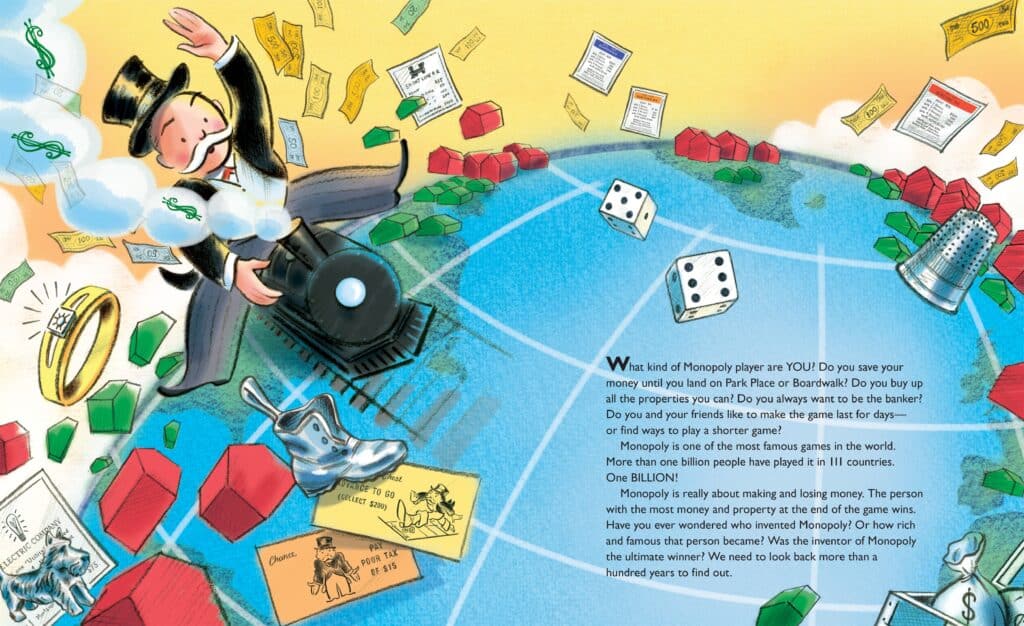
10. Picture books introduce readers to the flow of poetry.
Picture books serve as an excellent gateway to poetry for older readers, introducing them to the rhythmic cadence and expressive language inherent in poetic verse while highlighting the benefits of picture books for older readers.
Through the carefully crafted words and captivating illustrations found within picture books, readers are immersed in the melodic flow of poetry, experiencing the beauty of language in a tangible and engaging way. This exposure not only fosters an appreciation for the artistry of poetry but also helps develop crucial literary skills, such as recognizing literary devices, understanding symbolism, and interpreting themes.
Picture Book Example
Marshmallow Clouds: Two Poets at Play among Figures of Speech by Ted Kooser and Connie Wanek serves as an exemplary picture book that introduces older readers to the flow of poetry.
Through the collaboration of two distinguished poets, readers are immersed in a world of rich imagery, lyrical language, and playful exploration of figures of speech.
The beautiful pictures blend perfectly with the flowing words, wrapping readers in an experience that lets them dive into the magic of language in a way that’s easy to understand and enjoy.
As you can see with this spread, this picture book is a vivid and poetic journey.

11. Picture books inspire older readers.
Picture books possess the remarkable ability to instill a sense of wonder in older readers. These books transport readers to fantastical worlds, where anything is possible.
As older readers immerse themselves in the stories, they are inspired to dream big and pursue their passions with enthusiasm and determination.
Moreover, picture books often feature characters who overcome challenges, embrace diversity, and demonstrate resilience in the face of adversity. These characters serve as powerful role models for older readers, showing them that they too can overcome obstacles and achieve their goals.
By witnessing the triumphs and struggles of fictional characters, older readers are inspired to believe in themselves and recognize their own potential to make a difference in the world.
Picture Book Example
The Oldest Student: How Mary Walker Learned to Read by Rita Lorraine Hubbard is a remarkable picture book that tells the inspiring story of Mary Walker, who learned to read at the age of 116.
Through Mary’s journey, older readers are reminded that it’s never too late to pursue their dreams and passions.
Mary’s resilience and determination serve as a powerful example of the transformative power of education and lifelong learning. Her story inspires readers to embrace learning at any age and to believe in their ability to achieve greatness.
You won’t want to miss out on this captivating read-aloud!
12. Picture books teach older readers about friendship.
Picture books are filled with teachable moments, showcasing the significance of friendship through storytelling. They showcase the bonds formed between characters, emphasizing empathy, support, and the joys of companionship.
These narratives provide valuable lessons on building and nurturing relationships, teaching older readers about loyalty, forgiveness, and understanding in a relatable and engaging way. Through these tales, readers are encouraged to reflect on their own experiences with friendship and consider the significance of genuine connections in their lives.
Picture Book Example
In Pink and Say by Patricia Polacco, the story beautifully captures the essence of friendship amidst the backdrop of the Civil War.
The book follows the unlikely friendship between two young soldiers, Pinkus Aylee (Pink) and Sheldon Curtis (Say), who meet on the battlefield. Despite their differences the boys form a deep bond and support each other.
Through their experiences, readers learn about the power of friendship to transcend boundaries and provide strength in the face of adversity.
Take a look at this read-aloud to gain a clearer understanding of the story:
13. Picture books spread the message of kindness.
Picture books are powerful tools for instilling lessons of kindness and empathy in older readers. These books illustrate kindness through stories and images, guiding older readers to understand compassion. As they read, they learn to be more caring and empathetic towards others, which helps them see the world in a better way.
The benefits of picture books for older readers extend beyond mere entertainment to encompass valuable life lessons and moral teachings. By presenting relatable characters and real-life scenarios, these books offer older readers opportunities to reflect on their own actions and attitudes towards kindness. It’s learning in disguise!
The Boy Who Was Raised By Librarians by Carla Morris vividly illustrates acts of kindness through the nurturing care provided by the librarians to a young boy.
Their compassionate guidance and support shape the protagonist’s growth positively, showcasing the profound impact of kindness on his life.
As older readers follow the story, they see how kindness can change lives, inspiring them to be kind too. This touching reminder shows how important it is to care for others and build strong connections.
Check out this heartwarming story read aloud:
14. Picture books reveal global challenges to older readers.
Picture books offer older readers insights into global challenges, shedding light on issues such as poverty, environmental conservation, cultural diversity, and human rights. These books use interesting stories and illustrations to show what life is like in different places, helping readers understand the challenges people face.
Picture books teach older readers about the world and how we’re all connected. They make us think about big problems and how we can help make things better.
Picture Book Example
The Journey by Francesca Sanna is a touching picture book about a young girl and her family’s journey as refugees. The author does a great job capturing the challenges and resilience they encounter along the way.
With beautiful pictures and simple words, this story shows the tough times refugees face when they leave their homes in search of safety.
Through this story, readers learn about the challenges of displacement and the strength it takes to keep going.
Explore this read-aloud to uncover the impactful narrative found within this picture book, perfect for older readers.
15. Picture books facilitate environmental learning for children.
Picture books provide an engaging way for children to learn about the environment, covering concepts like conservation and biodiversity in accessible ways. Through captivating stories and illustrations, children are inspired to take responsibility for protecting the environment.
Additionally, the characters in picture books often model eco-friendly behaviors, encouraging children to take action and contribute to environmental preservation efforts in their communities.
Picture Book Example
We Are Water Protectors by Carole Lindstrom helps kids learn about protecting water and the environment. With its strong story and beautiful pictures, the book teaches young readers about the importance of protecting water sources and preserving the environment.
The story shows how everything in nature is connected and why it’s important to take care of the environment. Children learn about protecting water and are encouraged to become environmental advocates like the brave protagonist in the book.
This picture book also includes learning pages at the end, providing additional educational resources for children to deepen their understanding of environmental conservation. Additionally, it features a pledge to protect water, empowering young readers to take concrete action in safeguarding our planet’s precious resources.
Check out this read-aloud to experience the book’s powerful message firsthand!
These 15 benefits of picture books for older readers are sure to inspire educators and parents to incorporate them into their children’s reading routine.
The captivating example books immerse readers in vivid illustrations and engaging storytelling, fostering critical thinking skills, curiosity, and a passion for learning.

💡 Related Articles:
31 Captivating Picture Books for 5th Graders with Expert Tips for Selection
This is One of the Best Picture Books to Teach Vocabulary
25 Best Picture Books with Rich Vocabulary
35 Money Books for Kids that Teach Financial Literacy
19 Powerful Reasons Why Elementary Kids Need Summer Reading Logs
15 Exciting Library Scavenger Hunt Ideas To Do With This Printable
Picture Books Aren’t Just for Toddlers
Picture books are often linked with toddlerhood and early childhood development.
However, as you now understand, their appeal extends beyond that first plane of development. In fact, the benefits of picture books for children in the second plane of development, as outlined above in the list of 15 benefits, are numerous.
Picture books can serve as valuable sources of both learning and entertainment for older readers. They offer unique opportunities for exploring complex themes, enhancing comprehension skills, and sparking imagination, making them a versatile addition to any reader’s collection.
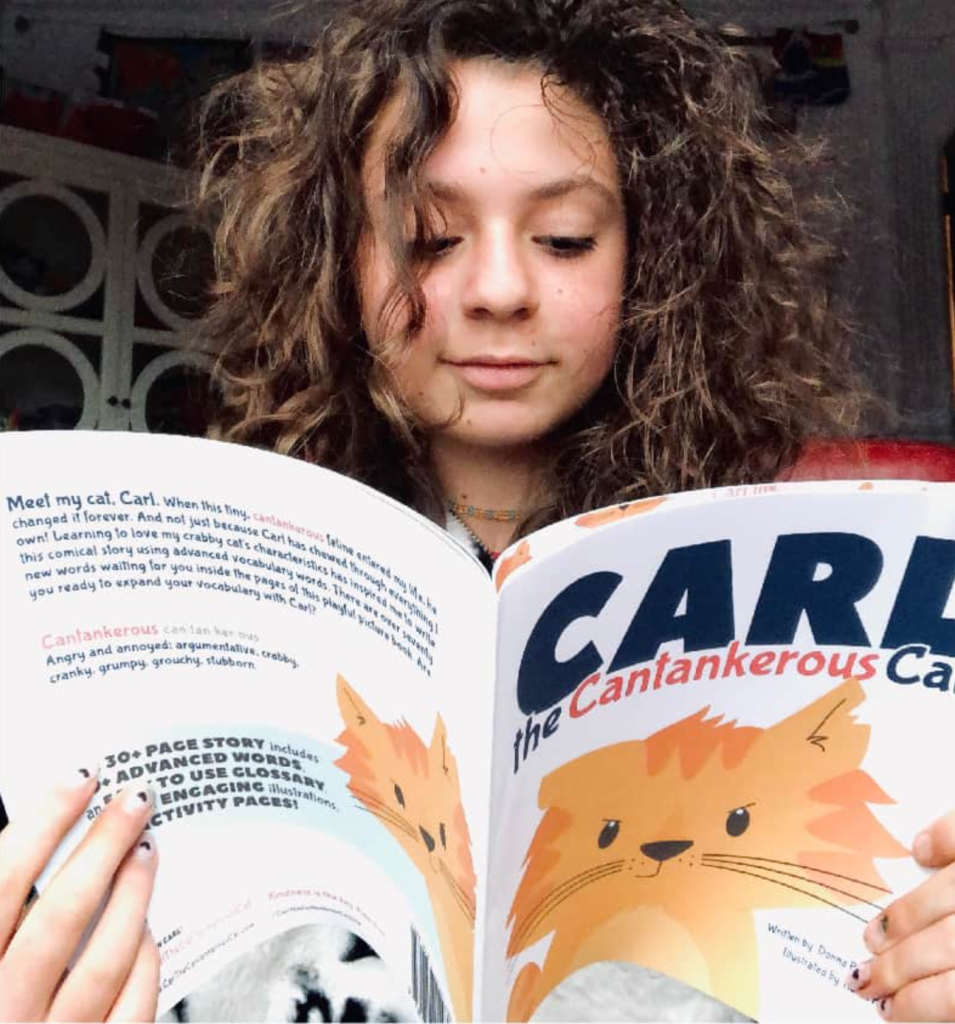
While picture books for toddlers typically cover basic concepts like colours, shapes, and simple vocabulary, those designed for older kids delve into more intricate and sophisticated themes.
These picture books can cover topics such as history, social issues, and emotional intelligence in a way that is both engaging and accessible to older readers. They often feature more detailed illustrations, complex storylines, and even sophisticated language that can challenge and inspire older readers.
You heard it here first: Picture books aren’t just for the little ones! Expand your library with picture books and explore the many benefits of picture books for older readers.
The Wrap-Up: Benefits of Picture Books for Older Readers
Picture books are indeed a timeless delight, transcending age and captivating readers young and old. Their unique blend of artistry and storytelling holds the key to unlocking the doors of imagination, critical thinking, and learning in disguise.
They explore complex themes, broaden horizons with diverse perspectives, and spark a love for reading in older children.
For parents nurturing their child’s reading journey or teachers seeking innovative tools to engage students, picture books should not be overlooked.
Uncover the wonders of picture books alongside your older readers, witnessing their enchantment with the artistry of words and visuals, and experiencing firsthand the many benefits of picture books for older readers.

📌 PIN this blog!
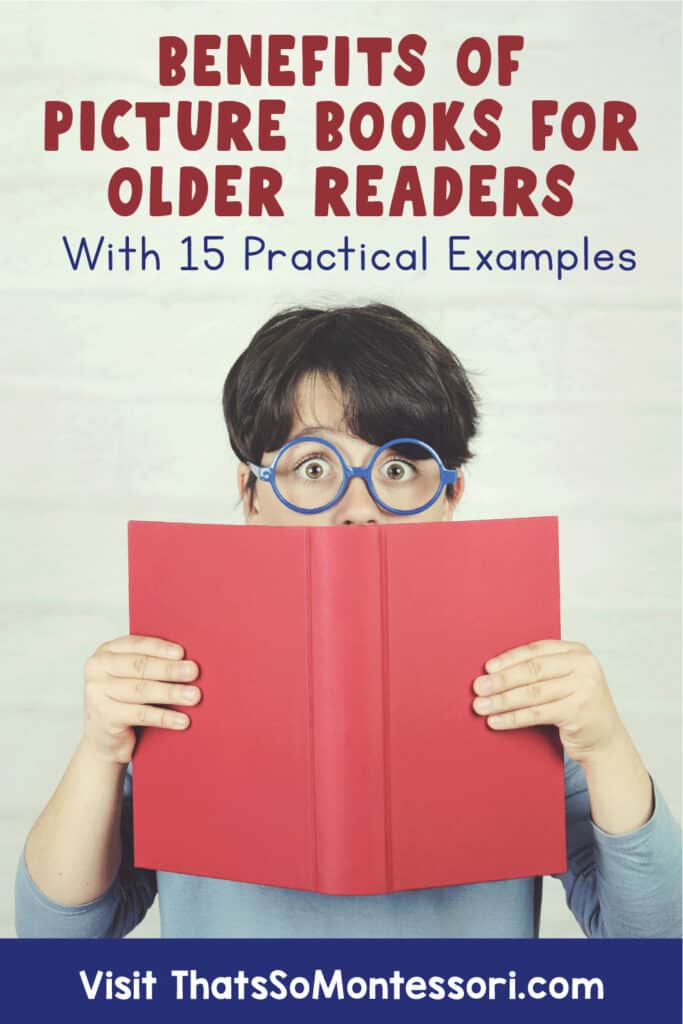
Keep Kids Busy With the Activities in These Blogs
Your Kids Need This Activity Book with Unique Drawing Prompts
9 Unique Rebus Puzzles with Answers for Kids
Book Report Ideas for 5th Grade that Spark Imagination
57 Epic Montessori-Aligned Spring Break Activities for Your Kids
31 Fun Summer Reading Activities Elementary Students Will Love
The Best Neighborhood Walk Scavenger Hunt
8 Easy Rebus Puzzles with Answers
Score Big with These 9 Super Bowl Classroom Activities
The Ultimate 13 Vocabulary Development Activities for Kids
27 Educational YouTube Channels to Prevent Summer Learning Loss

















